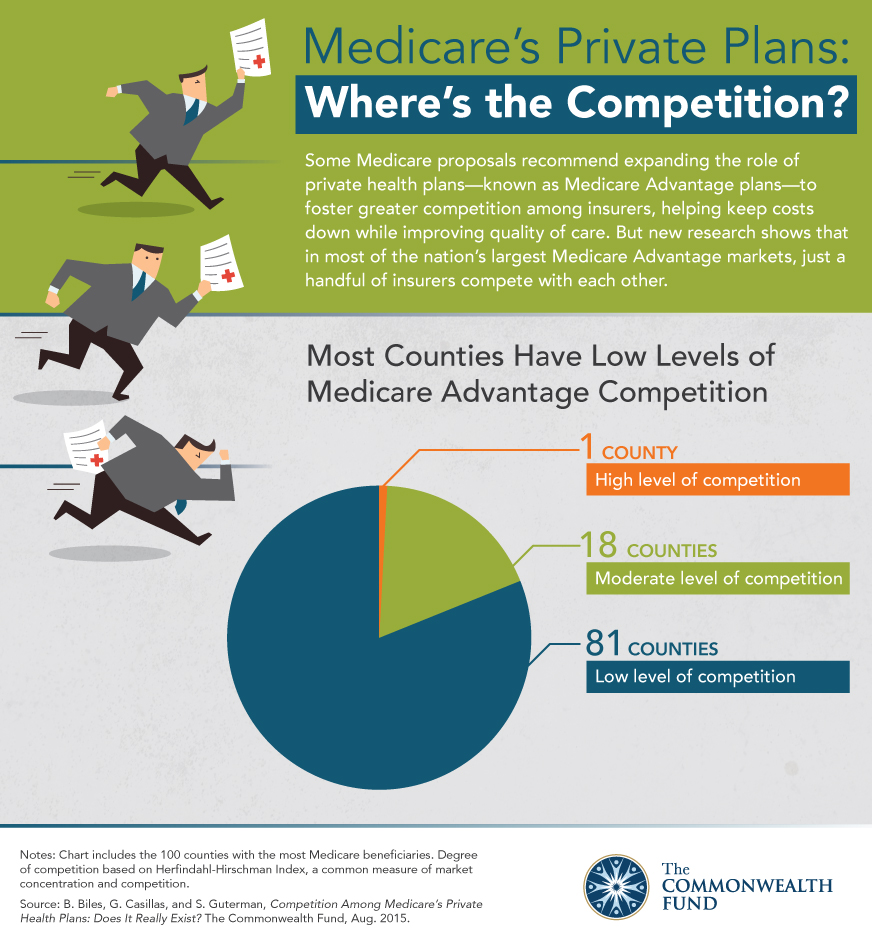New York, NY, August 25, 2015—There is little or no competition in Medicare Advantage insurance markets in 97 percent of U.S. counties, according to a new Commonwealth Fund report, which also finds that of the 100 counties with the greatest number of Medicare beneficiaries, 81 lacked significant competition.
The report, Competition Among Medicare’s Private Health Plans: Does It Really Exist?, suggests that lack of competition in local markets among private plans could create challenges for reform proposals that rely on competition among such plans to improve the efficiency and quality of the Medicare program. Among the nation’s 2,933 counties, only one—Riverside, Calif.—qualified as a competitive market and only 80 qualified as moderately competitive.
“Allowing private health insurers to play a larger role in Medicare is often suggested as a way to control Medicare costs and improve quality of care,” said Stuart Guterman, Senior Scholar in Residence at AcademyHealth and coauthor of the study. “The idea is if there are more insurers, they’ll fight for customers by lowering premiums and improving quality. For that to happen, however, we need to have enough insurers in a given market—and this study shows that, overwhelmingly, that isn’t the case.”
Using the U.S. Department of Justice and Federal Trade Commission’s standard measure of market competition, the report found:
- While both urban and rural Medicare Advantage markets lacked significant competition, rural counties were the least competitive.
- Six insurers dominated the markets in the 100 counties with the most Medicare beneficiaries. UnitedHealth had the greatest number of Medicare Advantage enrollees in 38 counties, while Blue Cross affiliates had the greatest enrollment in 13 counties and Humana in 12.
“Millions of Americans rely on Medicare and Medicare Advantage, and their ranks will grow exponentially as baby boomers turn 65,” said Commonwealth Fund President David Blumenthal, M.D. “Now is the time for us to focus on viable ways to strengthen Medicare, but this research suggests the need to critically examine, using empirical studies, the likely results of all proposals for Medicare reform, including those relying on market forces.”
The authors note that “although increased market power among health insurers may lead to lower prices from health care providers, it is not clear that it results in lower premiums for consumers and purchasers.” 
| Methodology |
|
Using March 2012 Medicare Advantage (MA) plan enrollment and payment data provided by the Centers for Medicare and Medicaid Services (CMS), we examined market concentration in all U.S. counties with 10 or more Medicare beneficiaries enrolled in an MA plan. We calculated the total payments from Medicare to each MA firm in each county for that month and then divided the total Medicare revenues paid to each firm by the total MA payments in the county. That amount was squared to determine the Herfindahl-Hirschman Index (HHI) score, a standard measure of market concentration, for each firm in each county. We then added the HHI scores for all MA firms in each county to deter-mine the county HHI score for all of the 2,933 counties in our data set. We separated the counties into three groups: counties with HHI scores of less of than 1,500 (nonconcentrated markets, which are considered more competitive); counties with HHI scores between 1,500 and 2,500 (moderately concentrated markets, which are considered moderately competitive); and counties with HHI scores of more than 2,500 (highly concentrated markets, which are considered less competitive). More detailed analysis was performed for the 100 urban counties with the largest numbers of MA enrollees. These counties had a combined total of 47 percent of MA enrollees and 38 percent of beneficiaries nationwide. |


